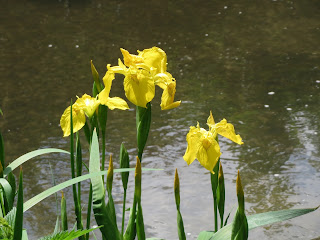 Campanula trachelium or nettle-leaved bellflower is a species of bellflower. It is a Eurasian blue wildflower native to Denmark and England and now naturalized in southeast Ireland. It is also found southward through much of Europe into Africa.
Campanula trachelium or nettle-leaved bellflower is a species of bellflower. It is a Eurasian blue wildflower native to Denmark and England and now naturalized in southeast Ireland. It is also found southward through much of Europe into Africa.The alternate name throatwort is derived from an old belief that C. trachelium is a cure for sore throat, and the species name trachelium refers to this old belief. There never was an actual medical benefit from the plant, which had no observable effect on the throat. But in past centuries, belief in the occult doctrine of signatures was very deeply stamped on superstitioius "believers".
 Other folknames include Our Lady's Bells because the color blue was identified with the Virgin Mary's scarf, veil, or shawl; Coventry Bells because C. trachelium was especially common in fields around Coventry; and "Bats-in-the-Belfry" or in the singular "Bat-in-the-Belfry", because the stamens inside the flower were like bats hanging in the bell of a church steeple.
Other folknames include Our Lady's Bells because the color blue was identified with the Virgin Mary's scarf, veil, or shawl; Coventry Bells because C. trachelium was especially common in fields around Coventry; and "Bats-in-the-Belfry" or in the singular "Bat-in-the-Belfry", because the stamens inside the flower were like bats hanging in the bell of a church steeple.ampanula trachelium is a perennial plant with one or more unbranched, often reddish, square-edged stems that are roughly hairy. The leaves grow alternately up the stems. The lower leaves are long-stalked and ovate with a heart-shaped base. The upper leaves have no stalks and are ovate or lanceolate, hairy with toothed margins. The inflorescence is a one sided spike with a few slightly nodding flowers. Each flower has five sepals which are fused, erect and hairy, and the five violet (or occasionally white) petals are fused into a bell that is hairy inside. There are five stamens and a pistil formed from three fused carpels. The fruit is a hairy, nodding capsule.














